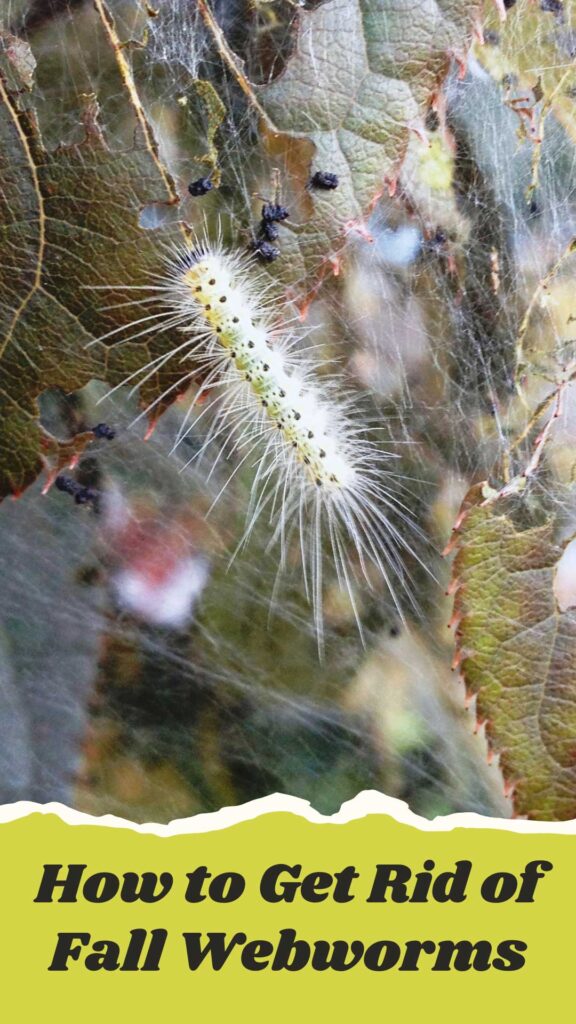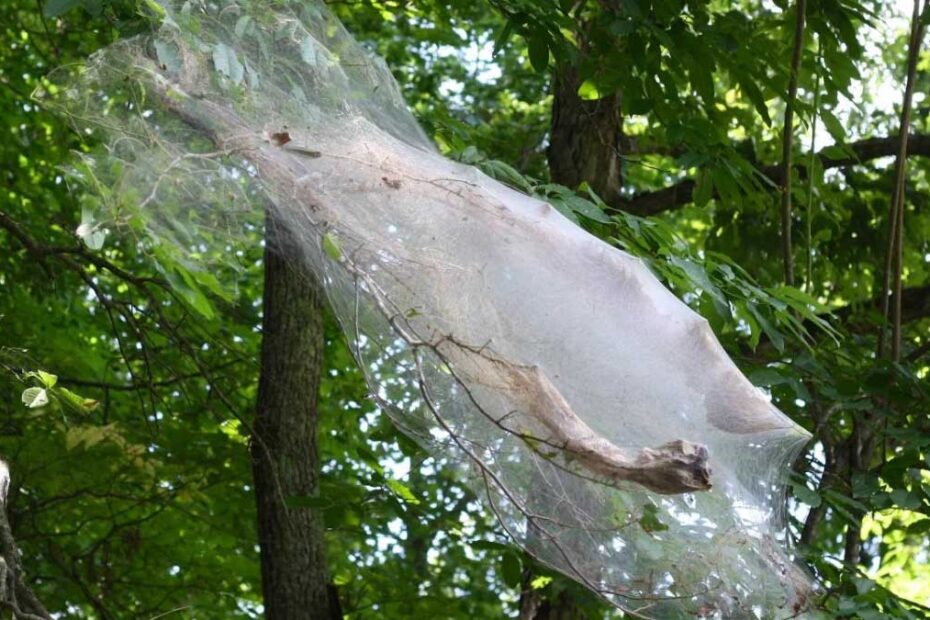Fall webworms can turn your beautiful trees into unsightly messes, covering branches with their dense, white webs. As the leaves change color and the air gets crisp, these pests emerge, feeding on the foliage and causing significant damage. If left unchecked, they can weaken your trees and make your yard look neglected.
You don’t have to let these pests take over your world. With a few targeted strategies, you can effectively manage and eliminate fall webworms from your property. By understanding their life cycle and knowing the right techniques, you’ll be well-equipped to protect your trees and maintain the health of your garden. Ready to reclaim your yard? Let’s jump into the best methods to get rid of fall webworms.
Key Takeaways
- Effective Management: Understand the fall webworm life cycle and signs of infestation to implement timely and effective control measures.
- Natural Remedies: Utilize beneficial insects, birds, and manual removal techniques to minimize chemical use and promote a healthy garden ecosystem.
- Chemical Treatments: Carefully select and apply insecticides like Bacillus thuringiensis (Bt) and spinosad, following safety guidelines for effective pest control.
- Preventive Measures: Regular tree maintenance, seasonal care, and early detection help prevent fall webworm infestations and keep trees healthy.
- Professional Help: Seek expert intervention for severe infestations, ineffective DIY methods, or when specialized equipment and comprehensive management plans are needed.

Understanding Fall Webworms
Fall webworms can cause significant damage to trees. Grasping their life cycle and recognizing infestation signs is essential to combating these pests.
Life Cycle and Habitat
Understanding the life cycle of fall webworms is crucial for effective control. They pass through four stages: egg, larva, pupa, and adult.
Eggs:
- Appearance: Small, light green or yellow
- Location: Laid on the underside of leaves, often in clusters of up to 500
Larvae:
- Appearance: Caterpillars, about 1 inch long, with light-colored bodies and dark spots
- Habitat: Found inside webs spun over tree branches where they feed on leaves
Pupae:
- Appearance: Brown and cocoon-like
- Location: Created in soil, under leaf litter, or bark crevices
Adults:
- Appearance: Moth with white wings, sometimes marked with black or brown spots
- Lifecycle: Emerge in late spring or early summer to begin the cycle again
Fall webworms favor a broad range of trees, including:
- Fruit trees (Apple, Cherry)
- Shade trees (Oak, Elm)
- Ornamental trees (Maple, Walnut)
Signs of Infestation
Recognizing fall webworm infestations early helps limit damage.
- Webs: Webs covering the tips of tree branches are a primary indicator
- Defoliation: Leaves inside webs are skeletonized or consumed
- Caterpillars: Observe clusters of caterpillars within webs
Monitoring and immediate action, once these signs are visible, protect your trees effectively.
Natural Methods to Eliminate Fall Webworms
You can manage fall webworms naturally by using beneficial insects, birds, and manual removal techniques. These methods reduce the dependency on chemical treatments, making your garden healthier and more eco-friendly.
Beneficial Insects and Birds
Encouraging natural predators keeps fall webworm populations under control.
- Insects: Trichogramma wasps and tachinid flies parasitize webworm eggs and larvae, effectively reducing their numbers. Ladybugs and lacewings also eat webworm larvae.
- Birds: Species like chickadees, orioles, and woodpeckers feed on webworms. Attract these birds by:
- Setting up bird feeders and birdbaths
- Planting native shrubs and trees
- Providing nesting boxes
Manual Removal Techniques
Manually removing fall webworms prevents them from spreading and causing extensive damage.
- Pruning: Cut off and destroy branches with webs. This is most effective when webs are small and localized.
- Physical Removal: Use a long pole or stick to puncture webs, then crush the larvae inside. This disrupts their habitat and exposes them to predators.
- Soap Solution: Mix water with mild dish soap and spray directly on webs. SOAP disrupts the larvae’s moisture barrier, leading to dehydration.
Carry out these techniques early in the infestation for better results. Consistently monitoring your trees promotes a healthy, webworm-free environment.
Chemical Control Options
Chemical control options can be effective in managing fall webworm infestations. When used correctly, these methods can significantly reduce populations and protect your trees from damage.
Insecticides and Pesticides
Selecting the right insecticide is crucial for effectively controlling fall webworms. Look for products containing Bacillus thuringiensis (Bt) or spinosad, as these are highly effective against caterpillar larvae.
Common Insecticides:
- Bacillus thuringiensis (Bt): A naturally occurring bacteria that targets the digestive system of caterpillars.
- Spinosad: Derived from a soil-dwelling bacterium, it effectively disrupts the nervous system of webworms.
- Carbaryl: A broad-spectrum insecticide that provides quick results but may impact beneficial insects.
Application Tips:
- Timing: Apply insecticides in the early larval stages for maximum effectiveness.
- Coverage: Ensure thorough coverage of affected areas, focusing on the webs.
- Frequency: Follow label instructions for reapplication intervals to maintain control.
Safety Precautions
Using chemical treatments requires adherence to safety guidelines to protect yourself, others, and the environment.
- Protective Gear: Wear gloves, goggles, and long sleeves to minimize exposure.
- Label Instructions: Read and follow all label directions to ensure safe and effective use.
- Environmental Concerns: Use targeted applications to minimize impact on non-target species and the surrounding ecosystem.
Adhering to these guidelines, you can effectively manage fall webworms while ensuring safety and environmental responsibility.
Preventive Measures
Preventive measures help avoid fall webworm infestations and maintain tree health. Implementing the right strategies ensures trees remain resilient against these pests.
Tree Maintenance
Proper tree maintenance creates a less favorable environment for fall webworms. Follow these key practices to improve tree health and reduce the risk of infestation:
- Regular Pruning: Remove dead or infected branches to allow better air circulation and sunlight penetration.
- Tree Health Monitoring: Inspect trees frequently for signs of stress or pests. Early detection leads to faster management.
- Mulching: Apply a layer of mulch around the base of trees, ensuring it doesn’t touch the trunk. Mulch retains soil moisture and regulates temperature.
- Fertilizing: Provide appropriate nutrients based on soil tests. Healthy trees are more resistant to pests.
Seasonal Care
Seasonal care ensures trees are prepared before webworms become active. Adopt these seasonal practices:
- Early Spring: Inspect trees for egg masses on the underside of leaves. Remove them manually or treat with horticultural oil.
- Late Spring/Early Summer: Monitor for the appearance of adult moths. Carry out lighting controls to reduce moth attraction.
- Mid-Summer: Look for initial web formation in branches. Use targeted insecticides if necessary.
- Fall: Post-harvest, clean up fallen leaves and debris around trees to eliminate potential pupating sites.
Taking these preventive measures supports tree health and minimizes the impact of fall webworms. Regular maintenance and seasonal care ensure a long-term, sustainable approach to pest management.
When to Seek Professional Help
If handling fall webworms feels overwhelming, professional assistance may be needed. Certain situations demand expert intervention for effective pest control. Knowing when to call a specialist prevents further damage and ensures tree health.
Severe Infestations
Certain conditions warrant prompt professional help:
- High Web Density: When webs cover large portions of the tree, manual methods may be impractical.
- Multiple Trees Affected: Large infestations spreading across several trees should be managed by an expert to avoid extensive damage.
Ineffective DIY Methods
If DIY techniques don’t produce desired results, consult a professional. Signs include:
- Recurrent Infestations: If webworms return even though various treatments, a professional can identify underlying issues.
- Persistent Damage: Ongoing leaf damage and defoliation, even after interventions, require expert evaluation.
Specialized Equipment
Some scenarios necessitate specialized tools or chemicals only professionals have:
- Tall Trees: For webs high in tall trees, professionals use equipment ensuring thorough removal.
- Resistant Webworms: If webworms resist over-the-counter insecticides, professionals have access to stronger, regulated products.
Comprehensive Management Plans
Professionals offer integrated pest management (IPM) strategies:
- Customized Solutions: Tailored treatment plans address specific infestation levels and tree types.
- Long-term Prevention: Ongoing monitoring, preventive measures, and maintenance plans help ensure webworms don’t return.
Tree Health Concerns
Seek help if tree health deteriorates due to infestations:
- Significant Defoliation: Extensive leaf loss impacts tree productivity and longevity.
- Secondary Pests: Infestations attract other pests or diseases, compounding the problem and requiring professional diagnosis and treatment.
Professional arborists and pest control experts provide robust solutions, ensuring your trees thrive even though the presence of fall webworms. Call experts at the first sign of severe infestation, persistent issues, or when specialized care benefits the overall health of your trees.
Conclusion
Effectively managing fall webworms requires a combination of early detection, natural methods, and, if necessary, chemical treatments. By understanding their life cycle and monitoring your trees, you can take timely action to protect your yard. Employing natural predators and manual removal techniques helps maintain a healthy environment while minimizing chemical use.
For severe infestations, professional help ensures comprehensive solutions and long-term prevention. Regular maintenance and preventive measures keep your trees healthy and resilient against future infestations. By staying proactive, you can enjoy a beautiful, webworm-free garden year-round.
Frequently Asked Questions
What are fall webworms?
Fall webworms are caterpillars that damage trees by creating webs on branches and feeding on leaves. These pests are known for their white webs and can cause significant harm to various tree types.
How can I identify fall webworms?
You can identify fall webworms by looking for webs covering tree branches, defoliation within the webs, and clusters of caterpillars with light-colored bodies and dark spots inside the webs.
Which types of trees do fall webworms prefer?
Fall webworms prefer a variety of trees, such as fruit trees like apple and cherry, shade trees like oak and elm, and ornamental trees like maple and walnut.
What is the life cycle of fall webworms?
Fall webworms have a life cycle with four stages: egg, larva, pupa, and adult. Eggs are laid on the underside of leaves, larvae feed on leaves inside webs, pupae form in soil or leaf litter, and adults are white-winged moths.
How can I naturally control fall webworms?
Natural control methods include attracting beneficial insects like Trichogramma wasps and birds such as chickadees. Manual techniques include pruning branches with webs, and using a soap solution to disrupt larvae.
Are there chemical treatments for fall webworms?
Yes, chemical treatments are available. Insecticides containing Bacillus thuringiensis (Bt) or spinosad are effective. It’s important to follow label instructions, ensure proper timing and coverage, and take safety precautions.
What preventive measures help avoid fall webworm infestations?
Preventive measures include regular pruning, frequent tree health monitoring, applying mulch, and proper fertilization. Seasonal care, like inspecting for egg masses in early spring, is also crucial.
When should I seek professional help for fall webworm infestations?
Seek professional help for severe infestations, when multiple trees are affected, or if DIY methods fail. Professionals can offer specialized equipment, chemicals, and comprehensive management plans for long-term prevention.
